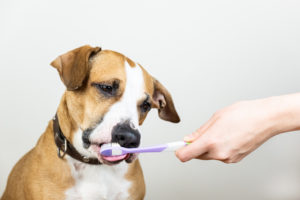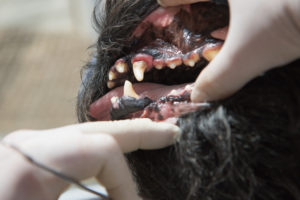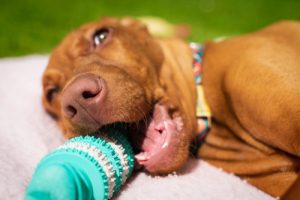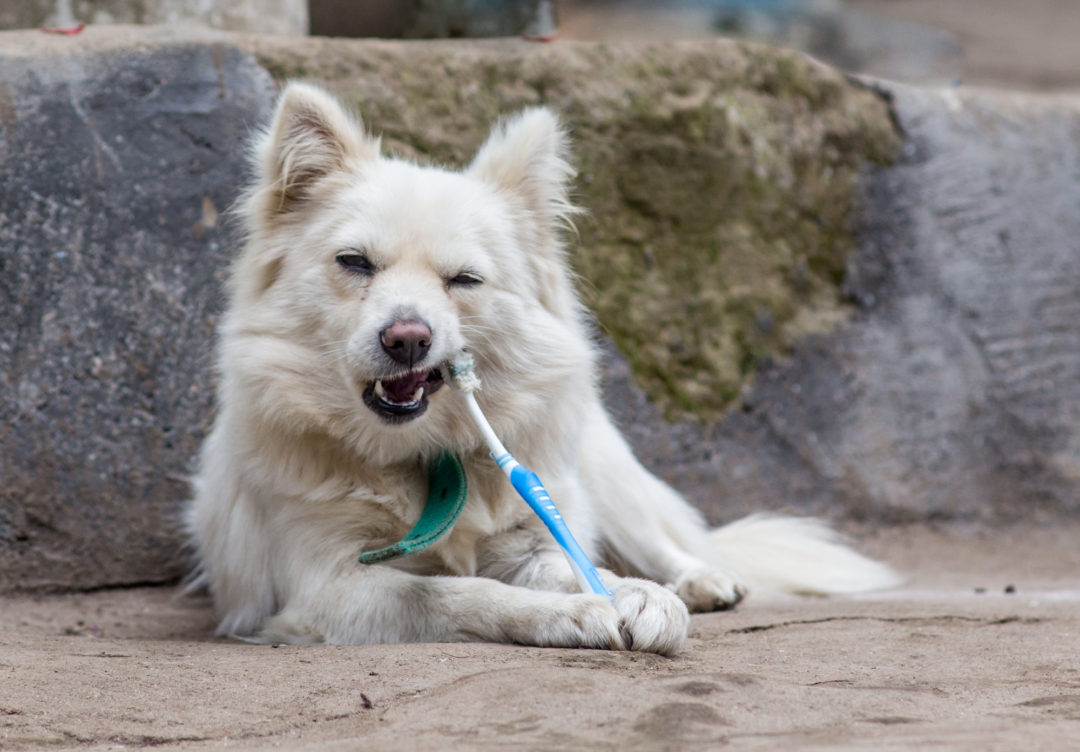Does your dog smile? Do you notice those pearly whites, or does it make you cringe to see red swollen gums and tartar covered teeth?
 February is Pet Dental Health Month. Media will be talking about brushing our dog’s teeth regularly, and ads will pop up with innovative ways to keep your dog’s teeth clean. There is some merit in most of these products, but they won’t do the job of regular tooth brushing. Just like our own teeth, our dog’s teeth need to be thoroughly cleaned to stay healthy and pearly white, brushing is still the best way to do that. Starting a regular routine of brushing your puppy’s mouth is easy and fun for your pup at the early stages of its life. As they get older, it can be a bit more challenging, but it’s still quite possible and can be an enjoyable time you spend with your dog.
February is Pet Dental Health Month. Media will be talking about brushing our dog’s teeth regularly, and ads will pop up with innovative ways to keep your dog’s teeth clean. There is some merit in most of these products, but they won’t do the job of regular tooth brushing. Just like our own teeth, our dog’s teeth need to be thoroughly cleaned to stay healthy and pearly white, brushing is still the best way to do that. Starting a regular routine of brushing your puppy’s mouth is easy and fun for your pup at the early stages of its life. As they get older, it can be a bit more challenging, but it’s still quite possible and can be an enjoyable time you spend with your dog.
Not all mouths are created equal. We have bacteria fighters in our mouths that dogs don’t. There’s good and bad in that. Humans have a digestive enzyme present in our mouths called Amylase. Amylase is an enzyme that breaks down carbs to sugar. When humans chew, Amylase starts off the whole digestive process. (The next time you eat bread, chew it a bit longer and you’ll notice it starts to get sweet—that’s the amylase at work!)
Dogs, being true carnivores, have wedge-like teeth designed for tearing their food. Humans have flatter teeth because we are omnivores and designed to eat both plants and animal proteins. The flat surfaces on our teeth allow the food, broken down by the enzyme amylase, to sit on our teeth and that can produce cavities. Since dogs don’t have Amylase and their teeth are designed for ripping and tearing, the food sits on the gums and in between the teeth. Interestingly, dogs rarely get cavities for this reason. However, plaque develops on the teeth potentially causing an opportunity of dental disease.
There is a theory that kibble or anything that’s crunchy will clean a dog’s teeth. This is true in part because crunchy things have edges that will scrape the teeth. However, it’s the carbs leftover that set up the development of plaque. Without removing the plaque, it begins to harden into a calcium-like substance called tartar. We get it on our own teeth and need to have it scaled off, and the same is true for dogs.

After a time, tartar accumulates on the teeth and begins to irritate the gums. You’ll notice your dog’s gums are red, they may not like chewing, there may be some bleeding you notice and their breath will be smelly. This is gingivitis. Left alone, it will create pockets in the gum line creating an opportunity for the bacteria to create an abscess or infection. When this happens, your dog has periodontal disease, which causes many health serious problems because it allows the bacteria to enter the bloodstream and can affect the heart, liver, and kidneys of your dog.
 Letting your dog have a rope toy to chew is great for doing some surface cleaning. The rope rubs their teeth and flosses them in a sense, but it doesn’t do the whole job.
Letting your dog have a rope toy to chew is great for doing some surface cleaning. The rope rubs their teeth and flosses them in a sense, but it doesn’t do the whole job.
If brushing your dog’s teeth sounds intimidating to you, there are a multitude of products on the market designed to keep your dog’s teeth cleaner:
- There are water additives that are said to dissolve plaque and tartar.
- Dental treats designed to set up an enzyme action in your dog’s mouth that will help break down the plaque.
- Powders you sprinkle over their food that may break up tartar.
- Dental toys and chews designed to scrape the teeth
None of these products will produce the results of a good tooth brushing.
Dogs are usually pretty receptive to having their teeth brushed and there are specific ways to introduce this routine to them. I’ve written about it in another article on my blog.
Keeping your dog’s teeth clean and having a regular dental hygiene routine at home, as well as having your vet monitor your dog’s oral health, is a good way to ensure your furry friend will enjoy a long and happy life free from dental pain and discomfort.
So, have you checked your dog’s teeth lately? How do they look? Let me know in the comments below.

